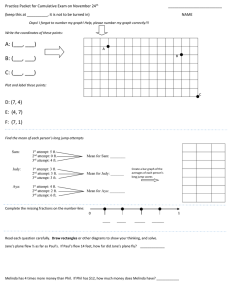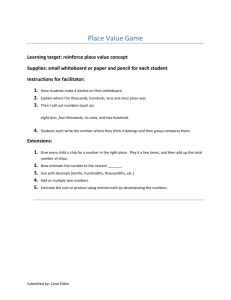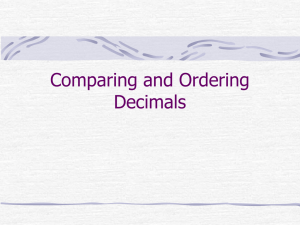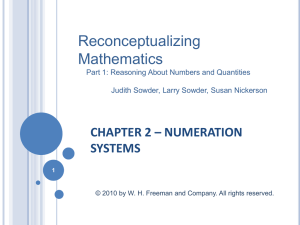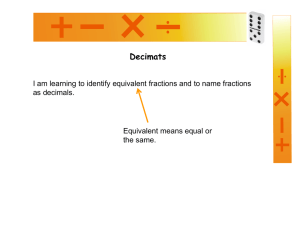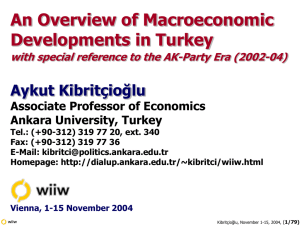CPM Lesson 1.1.3
advertisement
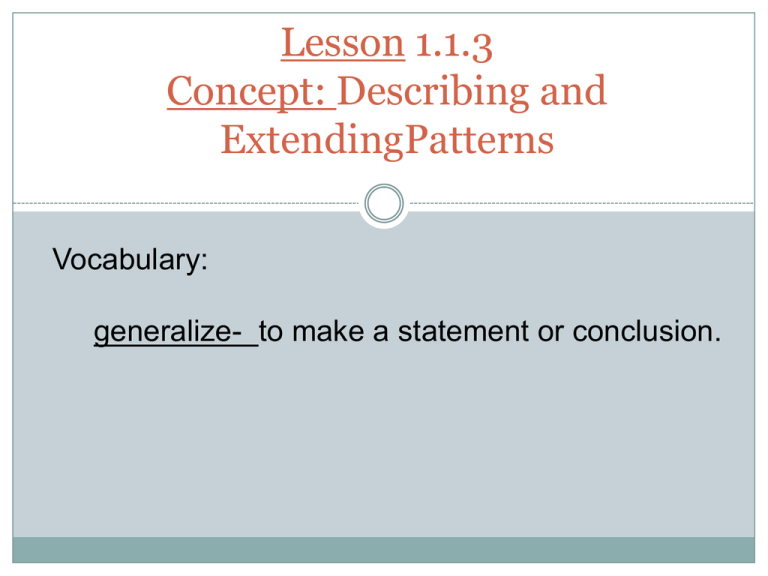
Lesson 1.1.3 Concept: Describing and ExtendingPatterns Vocabulary: generalize- to make a statement or conclusion. Patterns are everywhere! You may have noticed them in pine cones, flowers, stacks of cans in the grocery store, or many other places. Patterns are interesting partly because of the many ways that you can see or interpret how the parts of a pattern are changing. In this course, you will often be asked to look for multiple ways of seeing a pattern or concept. As you study the pattern in this lesson, work with your team to find multiple ways to see and describe the pattern and how it is growing. The following questions can help guide your discussion… • How can we describe the pattern? • Is there another way to see or describe it? • Does anyone see it differently? # 1-15. DOT PATTERN Copy the dot pattern below onto graph paper. Explore using the 1-15 Student eTool (CPM). a. What should the 4th and 5th figures look like? Draw them in your notebook. b. Describe the way the pattern is growing? Can you find more than one way? c. How many dots would be in the 10th figure of the pattern? What would it look like? Draw it. d. How many dots would be in the 30th figure? How can you describe the figure without drawing it? Can you describe it with words, numbers, and a diagram? Be ready to explain your ideas to the class. 1-16. With your team, prepare a stand-alone poster. It should show your description of the dot pattern in problem 1-15 and your prediction. “Standalone” means that anyone looking at your poster should be able to understand your thinking without any further explanation. Your poster should include: • Clear drawings of the 4th and 5th figures of the pattern. Use color to help you show how you see the pattern. • An explanation of the different ways that you see the pattern you found. Find ways to help your classmates understand how you saw the pattern. •Your prediction for the 30th figure with a clear explanation. 1-17. To generalize means to make a statement or conclusion about the common properties of a set of items. Work with your team to generalize this pattern by finding a way to describe any figure in the pattern. In other words, if you knew a figure number, how could you decide what the figure looks like even if you cannot draw it? Be ready to share your ideas with the class. # 1-18. Additional Challenge: Study the dot pattern below. Explore using the 118 Student eTool (CPM). Tonight’s homework is… Review & Preview, page , problems #1-19 to #1-23. • Label your assignment with your name and Lesson number in the upper right hand corner of a piece of notebook paper. (Lesson 1.1.3) •Show all work and justify your answers for full credit. place-value: The number assigned to each place that a digit occupies. In our number system, place values are all powers of 10. (example: 1, 10, 100, 1000…) • Starting from the left side of the decimal point, the place values are: ones, tens, hundreds, thousands, ten thousands, and so on. • On the right side, the place values are tenths, hundredths, thousandths and so on. • In the example below, the place occupied by 8 has the value of 100, so the value of the digit 8 is 800. •The number above is read, “nine thousand, eight hundred seventy-six and five hundred forty-three thousandths.” • The number 64.3 is read, “sixty-four and three tenths.” • The number 7.17 is read, “seven and seventeen hundredths.” • The only time the word “and” is said when reading a number is at the location of the decimal point. Daily Closure: 1. Return Group folder to the math box. 2. Return your individual Concept Notebook to the math section of your binder. 3. Return the group supply box to the cart after making sure all supplies have been stored in the box and the lid is secured. 4. Record Review/Preview in student planner.
